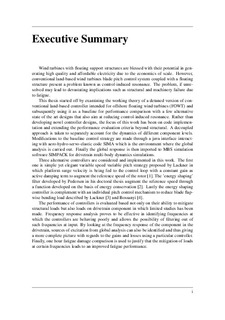| dc.description.abstract | Wind turbines with floating support structures are blessed with their potential in generating high quality and affordable electricity due to the economics of scale. However, conventional land-based wind turbines blade pitch control system coupled with a floating structure present a problem known as control-induced resonance. The problem, if unresolved may lead to devastating implications such as structural and machinery failure due to fatigue.
This thesis started off by examining the working theory of a detuned version of conventional land-based controller intended for offshore floating wind turbines (FOWT) and subsequently using it as a baseline for performance comparison with a few alternative state of the art designs that also aim at reducing control-induced resonance. Rather than developing novel controller designs, the focus of this work has been on code implemen- tation and extending the performance evaluation criteria beyond structural. A decoupled approach is taken to separately account for the dynamics of different component levels. Modifications to the baseline control strategy are made through a java interface interacting with aero-hydro-servo-elastic code SIMA which is the environment where the global analysis is carried out. Finally the global response is then imported to MBS simulation software SIMPACK for drivetrain multi-body dynamics simulations.
Three alternative controllers are considered and implemented in this work. The first one is simple yet elegant variable speed variable pitch strategy proposed by Lackner in which platform surge velocity is being fed to the control loop with a constant gain as active damping term to augment the reference speed of the rotor [1]. The ’energy shaping’ filter developed by Pedersen in his doctoral thesis augment the reference speed through a function developed on the basis of energy conservation [2]. Lastly the energy shaping controller is complement with an individual pitch control mechanism to reduce blade flap- wise bending load described by Lackner [3] and Bossanyi [4].
The performance of controllers is evaluated based not only on their ability to mitigate structural loads but also loads on drivetrain component in which limited studies has been made. Frequency response analysis proves to be effective in identifying frequencies at which the controllers are behaving poorly and allows the possibility of filtering out of such frequencies at input. By looking at the frequency response of the component in the drivetrain, sources of excitation from global analysis can also be identified and thus giving a more complete picture with regards to the gains and losses using a particular controller. Finally, one hour fatigue damage comparison is used to justify that the mitigation of loads at certain frequencies leads to an improved fatigue performance. | |
